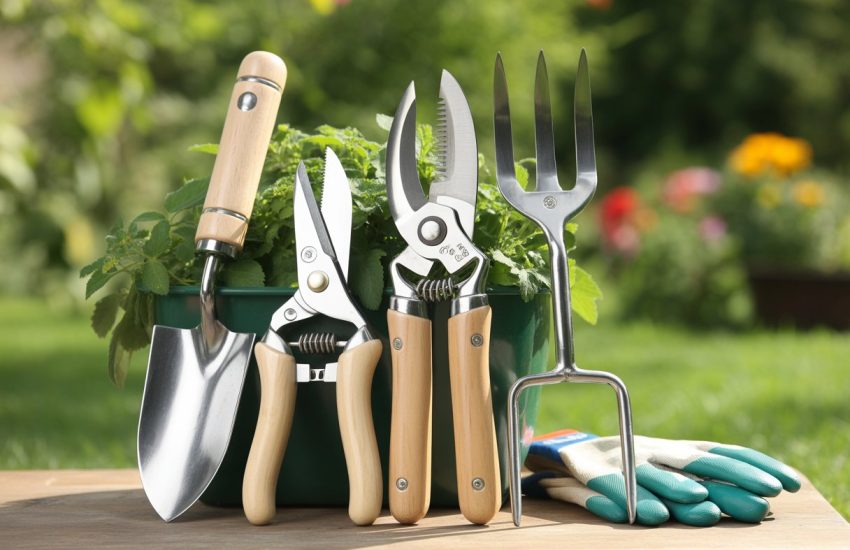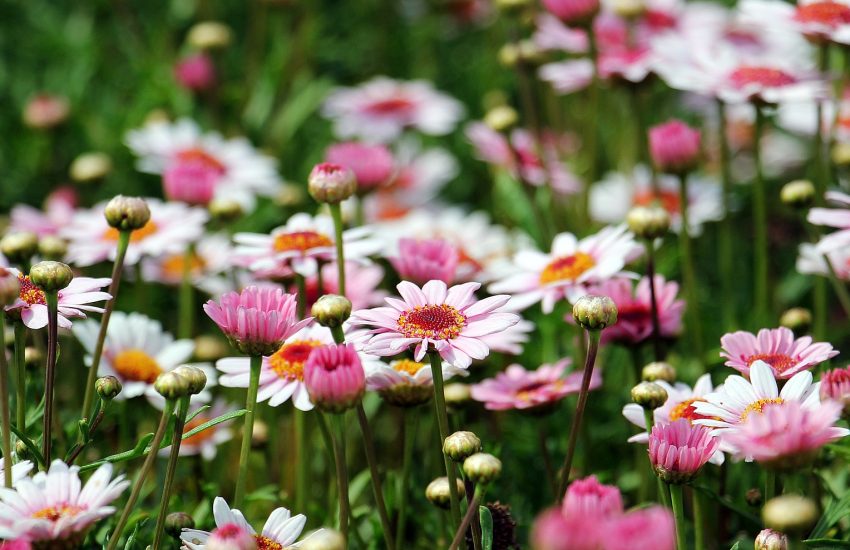7 Monstera Plants in the Wild
“Monstera”, is a popular genus that has over 45 plant species under it, which are hemi epiphytes (plants with two growth phases- terrestrial i.e. living on land, and epiphyte i.e. a plant that grows on another plant without being parasitic in nature). The word ‘Monstera’ is derived from a Latin word meaning monstrous or abnormal, which refers to the holes present on the leaves as the plant matures.
The species of the Monstera genus include species with deep splits as well as species with no split and complete margin. The plants are poisonous yet bear delicious fruits (only when it ripens, otherwise it too is poisonous), packed with nutrients rich in Vitamin C, and B, protein, fiber, calcium, and phosphorus with zero fat.
Wild Monsteras are native to tropical regions of Central America including countries like- Mexico, Cost Rica, El Salvador, Belize, and Panama. The species require tropical and humid climates with indirect sunlight for their growth and development.
They prefer partial sunlight and a minimum of 2-5 hours of direct sunlight a day for better growth. The plants in this genus prefer warm and humid climate to grow well as houseplants as it grows in wild under similar climatic conditions.
For the first time, the existence of such plants was found by a French Botanist, Charles Plumier in 1693. And in 1763, these plants were officially named as “Monstera”, which has now become a common and popular house plant species all around the globe.
In fact, we all love Monstera as a home décor plant. But, have you wondered how these beautiful perennials grow in their habitat, in the wild? So, without further ado, let’s discuss about the different species of monstera in the wild.
Monstera deliciosa in the wild
Monstera deliciosa is the most common and popular species of Monstera, we know. It is also known as the “Swiss cheese plant” and is famous for its large, dark green, and glossy leaves. M. deliciosa is native to the Tropical Rainforest of Southern Mexico, South of Panama. It is a member of the Araceae family and amongst the hemi epiphytes of the Monstera genus. The plant is toxic in nature except for the fruit, which only when ripens.
In its natural habitat, the plant can grow up to 70 feet when supported by a sturdy tree which it can climb easily with the help of its aerial roots. The flowers of the plants are green and creamy, white in color with spadix-type inflorescence. The fruit is covered with hexagonal scales and is edible only when it ripens shedding its scales naturally.
See Also: West Indian Lantana Plant, Grow, Care
Note- Monstera deliciosa produce flowers and fruits only in wild form and not as a houseplant.
M. deliciosa has many varieties that include var. Brazil, var. brosigiana, var. sierrana etc. And the variegated varieties include the famous Thai constellation (a variegated Monstera plant that has cream or yellowish color spots on its leaves) and albo borsigiana (a rare variegated variety of Monstera with white-green leaves).

Monstera adansonii
M. adansonii is also known as ‘Monkey Mask’, and ‘window leaf’. The varieties under this species are slightly different from Monstera deliciosa as some varieties of M. adansonii does not have holes or fenestrations and in other varieties only 1-2 holes are present. Only some plants develop 1 or 2 holes at maturity and that too at very early stages in life. M. adansonii is widespread in tropical regions of Central and South America. The plants in this genus are small and can grow up to 20 feet. The flowers are usually cream to yellow or orange in color while the inflorescence is small in size and the color of the spathe is somewhat cream to pale yellow. Fruits of the plant are initially green in color and turn yellow when it ripens.
Monstera adansonii var. laniata is the most famous amongst the other varieties due to its fenestrations starting down from the middle of the leaves. The species of adansonii is a little easier to take care of as compared to the other species till it gets bright, partial sunlight, well-drained loamy soil, and other favorable conditions.
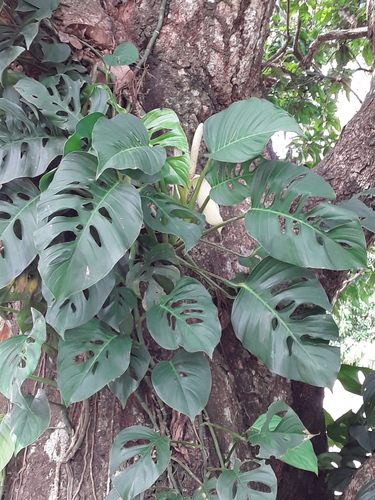
Monstera obliqua in the wild
This species of the genus Monstera is expensive and rare to find. M. oblique is also known as the “Unicorn of the houseplants”. The specie is native to Central and South America and is hemiepiphytic like other species of the Monstera genus. The plant of this specie is smaller in size compared to others. It can grow up to 4 to 16 feet and this makes it a smaller specie. This specie is rarely cultivated and is similar in appearance to Monstera adansonii. The leaves of the plants are generally narrow with large holes and have dark green leaves.
The plant is most commonly known for its foliage-fenestrated leaves that are numerous in number and have even more empty spaces than the leaf itself. The plants periodically produce side shoots which are known as Stolon. The plant has clusters of 6-8 spadices and green to white color spathe. The flowers are deep yellow in color and the fruit is initially olive-green to green in color but turns into deep orange after the fruit ripens. Monstera obliqua varieties include var. Peru, var. Bolivia etc.
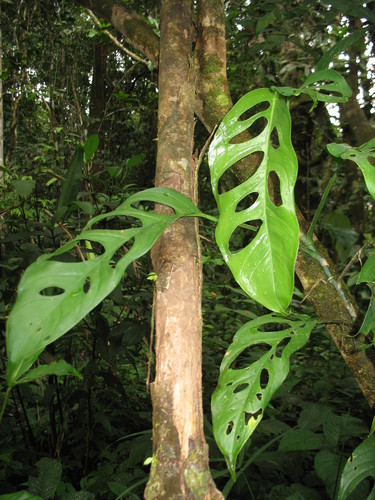
© Ana Maria Benavides
Monstera siltepecana in the wild
Monstera siltepecana is a stunning plant with leaves that are light green in color with silver-grey markings on them. Thus, it is also known as “Silver Monstera” as the leaves have a silvery shimmer to them. The leaves of the plant have large fenestration along with 2-4 holes on each of the side midrib and complete margin. Its beautiful metallic foliage is the reason that the plants of this species are appreciated. M. siltepecana has two stages- The Juvenile stage during when the leaves are small, green, and silvery and grows upwards attaining bigger and green foliage. And the Adult stage is when the leaves of the plant are dark greenish in color and this is the stage wherein fenestration occurs in the leaves.
A mature siltepecana undergoes a change after it loses its silvery shimmer. The plant reaches a height of 8 feet. The plant’s flowers are white in color and the spathe seems white from the outside and from the inside it is red in color. The varieties of M. siltepecana include the famous variety called El Salvador which is slightly different from the regular siltepecana because of its larger leaves and faster growth than its counterpart.
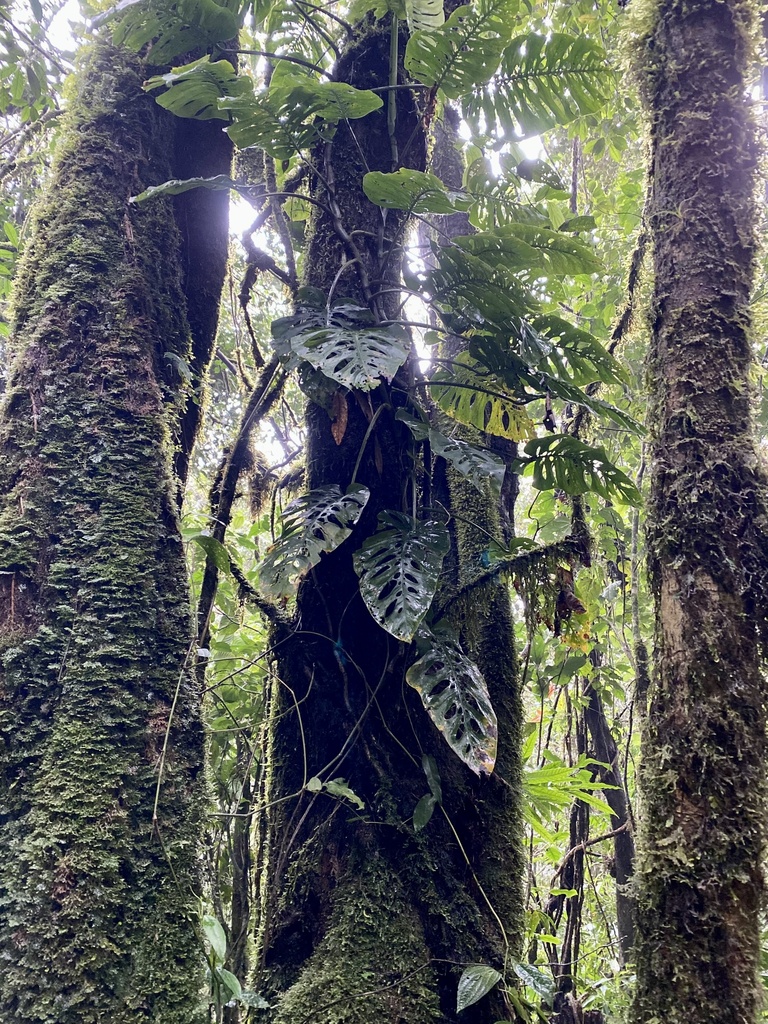
Monstera dubia in the wild
This beautiful specie of Monstera is actually the smallest and the less known specie among the other Monstera species. It is native to tropical regions of Central and South America. It is also called the “Shingle Plant” as its leaves seem so flat on the tree it climbs that it actually appears like shingles. This plant is more likely to be found in wet areas of Mexico and Brazil’s rainforests. The leaves of the plant are small, heart-shaped with massive fenestration that covers most part of the leaves. And when the plant matures the color of the leaves becomes dull green.
At maturity, the plant gets exposed to the sunlight due to the vine climbing up the tree and reaching the canopy. The flowers of this plant are white in color with the spathe being rose-colored from the outer side and whitish inside and the flowers are yellowish in color. M. dubia slightly resembles Monstera deliciosa in the wild due to its light green and dark green leaves.
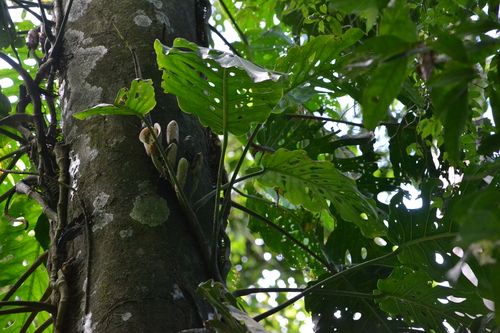
© Letizia Weichgrebe
Monstera lechleriana in the wild
M. lechleriana is a rare plant that is expensive and only a few plant growers grow them. It is native to Venezuela, Bolivia, Colombia, Peru, and Panama. It prefers a humid climate and moist soil with better drainage. The leaves are large, glossy, and oval in shape with beautiful fenestrations that grow when the vine matures and gets enough sunlight. Too much sunlight could burn the foliage of the plant as it is used for partial or indirect sunlight. Leaves do have elliptical holes on each side of the midrib but in some plants, holes may not be present and they could lack margins. When the plant is young the leaves are oval-shaped.
Lechleriana has a cluster of 12-15 flowers that makes the plant a worthy one. The flowers of the plant are usually cream to pale yellow in color with spathe being white to pale yellow in color. Like all other Monsteras, it bears fruits in the wild that are cream to yellowish in color.
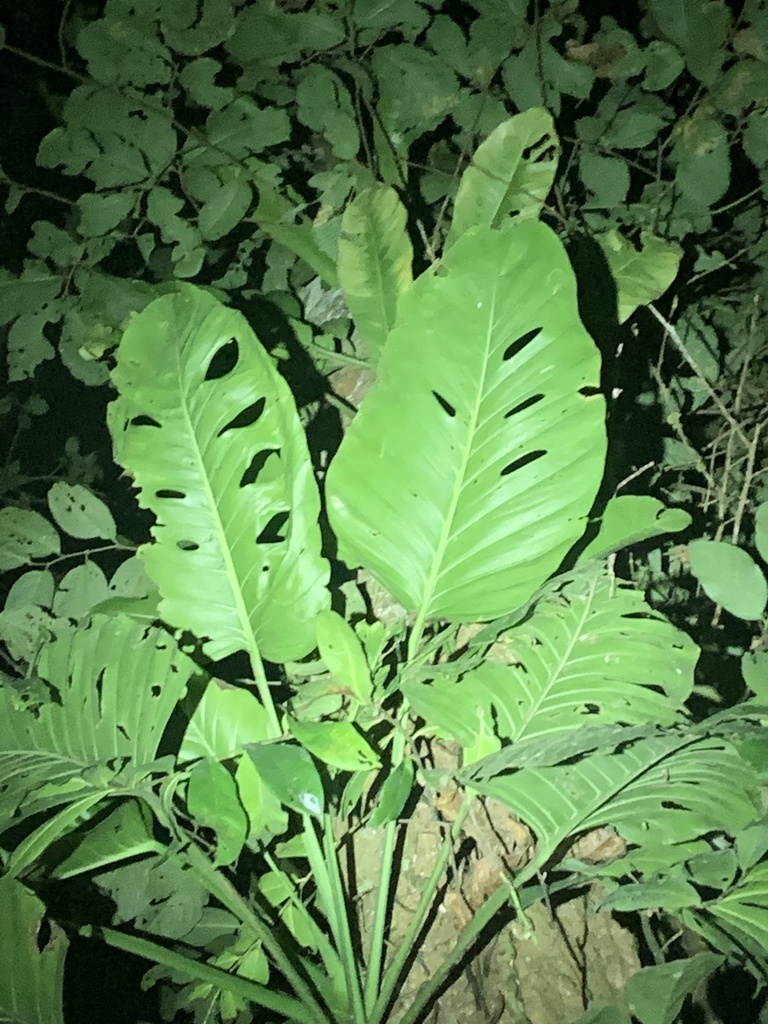
Monstera standleyana in the wild
Monstera standleyana is an adorable yet popular houseplant. Its elliptical, glossy green leaves make it look exotic. It is also known as Philodendron “Cobra” as it is a gorgeous climber. The specie is widespread in Costa Rica, Honduras, Nicaragua, and Panama. During summer and spring, under suitable conditions, the plant grows fast. In the wild, the plant has large, oval leaves with generally no fenestrations. But exceptions always exist, you know. The plant could grow up to 6 to 26 feet from the ground level. The spathe is cream to whitish in color that surrounds the flowers which are usually yellow to white in color.
G.S. Bunting describes the plant in 1967. The most famous variegated form of Monstera standleyana is M. standleyana var. ‘Aurea variegata’. It has creamy yellow variegation and is one of the rarest varieties.
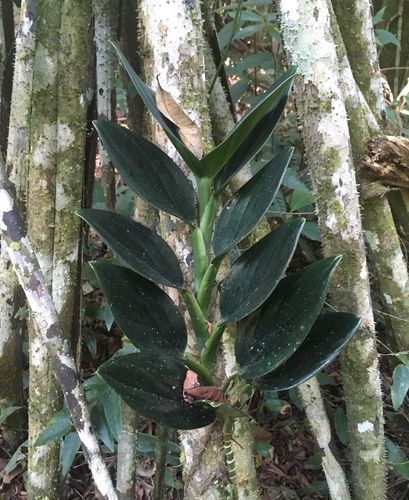
Conclusion
The Monstera plants we discussed are all rare and unique. All the species have different heights, leaf shapes, and sizes yet all of them are beautiful and stunning. In their natural habitat, they are climbers crawling on trees for more sunlight and support during high winds. Generally in wild conditions, they may grow up to 3 or 4 times more than in indoor conditions but their concise form to attracts plant lovers and it makes
Monstera is a great home décor plant if they are taken care of. Apart from their aesthetic uses, the plant has various medicinal, and therapeutic values the plant has itself valuable yet worthy to be taken care of. The plant is said to bring good luck and prosperity into people’s life.
The plants in this genus have surely become a part of our lives. Monstera being a plant that continuously keeps growing symbolizes longevity, respect, and wisdom of the elderly in Chinese culture. Hope the plants keep growing in wild and we keep loving and cherishing this plant forever.
FAQS
To make a clear understanding of the concepts we discussed, some of the FAQs have been answered below
Where I can find Monstera in the wild?
Monstera plants belong to the Monstera genus which has 45 hemiepiphytic species. The plants are commonly known as split-leaf philodendrons and are the natives of tropical regions of Central America including countries like- Mexico, Cost Rica, El Salvador, Belize, and Panama. All Monstera species require tropical and humid climates with indirect sunlight for their growth and development. They prefer partial sunlight and a few hours of direct sunlight a day for better growth. The species of Monstera has been introduced to many tropical regions apart from its wild habitat as houseplants due to their high demand as houseplants. Plants require warm and humid climate for proper growth as houseplants as it grows in wild under similar climatic conditions.
How big do Monstera deliciosa get in the wild?
Monstera deliciosa is one of the most common and popular species of the genus Monstera. It is native to the tropical Rainforests of Southern Mexico, South of Panama. As its name Monstera deliciosa suggests, the plant is monstrous in height. M. deliciosa is amongst one of the tallest Monstera species that grows enormous in wild conditions. In wild habitat, the plant can grow up to 70 feet in height when supported by a sturdy tree which Monstera can climb easily with the help of its aerial roots. The aerial roots of the plant come out from the stem that develops with the growth in plant height. The plant is famous for its large, dark green, ovulated, glossy leaves with many fenestrations on them.
How long can a Monstera live?
Monsteras are perennial plants that bloom annually. The life span of Monstera depends upon the climatic conditions of the place where the plant is growing. The plants being the natives of tropical regions of tropical rainforests of Central America including countries like- Mexico, Cost Rica, El Salvador, Belize and Panama require tropical and humid climates with partial sunlight for their growth and development. The plant can live for more than 40 years. Thus, they are also known as ‘Heirloom’ plants. In indoor conditions, the plant should be provided with ample sunlight, humidity, favorable temperature, and water for better growth and development of the plant. The fenestrations in the leaves of the Monstera plant tell when the plant has hit maturity or not as the splits in the leaves are produced by the mature plants only.
Why is Monstera Thai Constellation so expensive?
Monstera Thai Constellation is one of the most popular variegated varieties of Monstera deliciosa. Variegated varieties refer to plants with different colors due to a lack of chlorophyll or due to the presence of viruses. The plant has yellowish or cream spots on its leaves due to a lack of chlorophyll or viral causes. Monstera Thai Constellation is a perennial plant that has white flowers which only appear in wild habitats. The plant is unique in terms of the pattern making it rare to find as well as to propagate along with its high demand in the market. The plant is slow growing and requires more care and even in controlled conditions, there are chances that the progeny differs from the parent. This makes the plant highly expensive compared to the other varieties of Monsteras.

